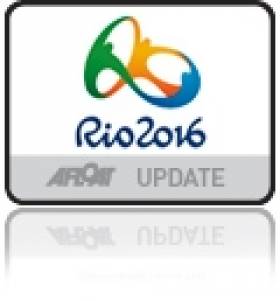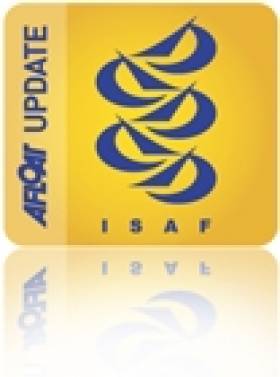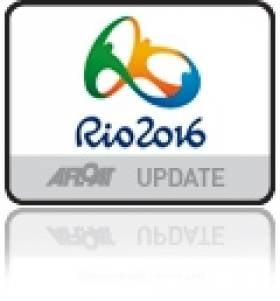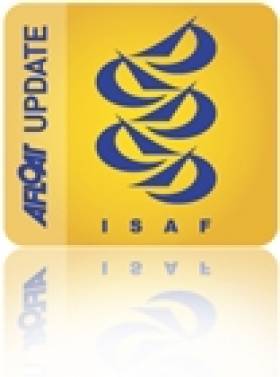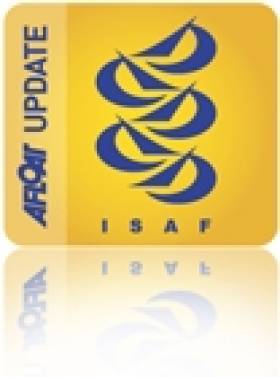Displaying items by tag: ISAF
Annalise Murphy Moves Up the Miami Scoreboard
#annalisemurphy – An eighth in race four scored yesterday helped Annalise Murphy climb ten places in the overall standings after six races at Miami Olympic classes regatta. The first World Cup event of 2014 has been subject to some pretty fickle conditions so far, not to the liking of the Irish Laser European champion who now counts (48), 35, 42 8, 29 and 26 to be 33rd overall in her 50–boat radial fleet.
The 2012 Olympic Silver Medalist Marit Bouwmeester (NED) made the most of Thursday's early afternoon gusts. She was dominant and won the first two of three races to move into second place behind defending champion Paige Railey (USA). In Race 4, Bouwmeester was in seventh at the first mark and sixth at the second. Nonetheless, the 2011 World Champion came from behind to win again. Race 5 was a duel between Bouwmeester, Railey and Anne-Marie Rindom (DEN). Bouwmeester had a slight lead around the first three marks, until Railey gained the advantage around the final mark. Bouwmeester bested Railey in the sprint to the finish by four seconds. Rindom was third.
The top four boats finished within 14 seconds of each other. Railey still holds an 11 point lead. Claire Merry (CAN) jumped to fourth place with a first place finish in Race 6.
#matchrace – ISAF have released details of two international Grade 'W' match racing events for which Match Racing Ireland are seeking teams. They are the ISAF Women's Match Racing World Championship and the ISAF Youth Match Racing World Championship.
Event details:
The ISAF Women's Match Racing World Championship
Venue: Royal Cork YC, Ireland
Dates June 3-8, 2014
NoR: http://www.sailing.org/36867.php
ISAF Youth Match Racing World Championship
Venue: Nylandska Jaktklubben, Finland
Dates: July 23-27, 2014
NoR: http://www.sailing.org/36865.php
Representatives of interested teams should contact Ric Morris ([email protected]) with team details as set out in the NoRs before January 29 in order to give our selected teams the best opportunity of success in these competitions.
ISAF Invites Applicants for Athlete Participation Programme
#isaf – The International Sailing Federation (ISAF) invites applications to the ISAF Athlete Participation Programme for the 2014 ISAF Youth Sailing World Championship.
The ISAF Athlete Participation Programme (APP) was created in 2002 and assists athletes with attending the ISAF Youth Sailing World Championship by offering coaching support and financial subsidies towards the entry fee and travel costs. The World Youth Sailing Trust provides a Championship coach. The APP is targeted at sailors from nations in Subscription Categories 1 and 2.
Priority will be given for new countries and for countries that have not participated in the ISAF Youth Sailing World Championship during the last two years.
Thanks to APP funding, sailors from the Cook Islands, Cuba, El Salvador, Serbia, Botswana and Paraguay have been able to compete at the ISAF Youth Sailing World Championship.
The 2014 ISAF Youth Sailing World Championship will take place in Tavira, Portugal from 12-19 July 2014.
The ISAF Youth Sailing World Championship is open to competitors aged under 19 in the year of the championship (i.e. for Ireland, under 19 on 31 December 2014) in the events and equipment listed below (all supplied), the Youth Worlds occupies a unique place in the sailing calendar. Simply getting to the championship is a major achievement for most as entry is limited to one boat per nation, per event, meaning sailors first having to win through their national qualification series.
Event - Equipment
Boy's One Person Dinghy - Laser Radial
Girl's One Person Dinghy - Laser Radial
Boy's Two Person Dinghy - 420
Girl's Two Person Dinghy - 420
Boy's Windsurfer - RS:X with 8.5m2 sail
Girl's Windsurfer - RS:X with 8.5m2 sail
Open Multihull - Sirena SL16
Open Skiff - 29er
www.isafyouthworlds.com
China, Australia Olympic Teams Dominate ISAF Sailing World Cup Melbourne
#rio – Five Medal Races wrapped up the action at ISAF Sailing World Cup Melbourne with two nations dominating proceedings, Ireland was not represented.
Australia dominated the multihull and skiff fleets whilst China locked out the opposition to take all six podium places in the RS:X.
A strong northerly breeze met athletes at Sandringham Yacht Club for the final day of ISAF Sailing World Cup Melbourne. With gusts over 20 knots there were thrills and spills aplenty on the Stadium course as fans gathered on the Yacht Club balcony to enjoy the spectacle.
Top three by class:
2.4 Metre
1. Paul Francis, NZL
2. Michael Leydon, AUS
3. Matthew Bugg, AUS
470 Men
1.Mathew Belcher / William Ryan
2. Sime Fantela / Igor Marenic, CRO
3. Angus Galloway / Tim Hannah, AUS
470 Women
1. Shasha Chen / Yang Gao, CHN
2. Sasha Ryan / Jaime Ryan, AUS
3. Nan Zhang / Xiao Lv, CHN
49er
1. Nathan Outteridge / Iain Jensen, AUS
2. David Gilmour / Sam Phillips, AUS
3. William Phillips / Rhys Mara, AUS
49erFX
1.Olivia Price / Eliza Solly, AUS
2. Haylee Outteridge / Ella Clark, AUS
3. Ragna Agerup / Maia Agerup, NOR
Finn
1. Bjorn Allansson, SWE
2. Oliver Tweddell, AUS
3. Jake Lilley, AUS
Kiteboarding Men
1. Florian Gruber, GER
2. Riccardo Andrea Leccese, ITA
3. Alejandro Climent Hernandez, ESP
Kiteboarding Women
1. Nuria Goma, ESP
2. Lisa Hickman, AUS
3. Natalie Clarke, AUS
Laser
1. Tom Burton, AUS
2. Thomas Saunders, NZL
3. Matthew Wearn, AUS
Laser Radial
1. Tatiana Drozdovskaya, BLR
2. Dongshuang Zhang, CHN
3. Krystal Weir, AUS
Nacra 17
1.Darren Bundock / Nina Curtis, AUS
2.Euan McNicol / Lucinda Whitty, AUS
3.Jason Waterhouse / Lisa Darmanin, AUS
RS:X Men
1.Chuankun Shi, CHN
2. Chunzhuang Liu, CHN
3. Zhennan Fang, CHN
RS:X Women
1.Manjia Zheng, CHN
2. Qiaoshan Weng, CHN
3. Peina Chen, CHN
SKUD 18
1. Jovin Tan / Desiree Lim, SIN
2. Duncan MacGregor / Liesl Tesch, AUS
3. Amethyst Barnbrook / Brett Pearce
Policing Sailor's ISAF Categories Raises the Tempo at ICRA Conference
#icra – Of all the items on Saturday's ICRA cruiser conference agenda the 'liveliest' issue debated was how ISAF sailing categories are to be policed at future ICRA cruiser national championships.
A gathering of 110 downstairs in the Royal Irish Yacht Club, Dun Laoghaire found fertile ground for debate and there were many opinions and suggestions on how the difference between 'professional' and 'amateur' sailors should be treated. There was little in the way of consenus, however, about whether professionals should be restricted from competing at the National Championships.
Currently, two professional sailors are permitted in class zero, one in class one and none below that.
After a good solid debate, ICRA Chair Nobby Reilly deferred the matter and asked for any further contributions by email.
The ISAF Sailor Classification system provide events and classes with an international system of classification for sailors to provide a clear distinction between 'professional' and 'amateur' sailors. At last year's ICRA Nationals professional sailors were limited but how the rule was policed in Fenit left many asking questions.
Reilly's deferral however didn't stop the chat on the contentious topic. The après conference in the bar – where one insider says the real talking on the matter was done – focussed on a resolution of the issue. The ICRA Notice of Race for the 2014 championships is now published and ICRA is expecting sailors to respect the rule. 'The intention is for it to be self policing because ICRA has not got the resources to handle the administrative burden the ISAF system brings', one ICRA source told Afloat.ie
The ISAF Sailor Classification Code defines how sailors are classified but it is the responsibility of sailors to apply for a classification and provide all information necessary to determine his or her classification.
The hope now is that debate on the issue has raised awareness.
Disabled Sailing World Body To Merge With ISAF
#IFDS - The International Association for Disabled Sailing (IFDS) has agreed to a merger with the International Sailing Federation (ISAF) that will secure the future of competitive sailing for athletes with disabilities.
The ISAF's official website explains that the merger, to be completed in 12 months' time, will create a single governing body for member national authorities and sailors alike "to better serve the needs and interests of sailors with disabilities".
IFDS president and former Irish Paralympian John Twomey said he was "delighted" at the agreement and said he and his team "look forward to implementing" the new alliance, which would provide for consistent regulations across all sailing classes, both able bodied and differently abled.
The functions of the current IFDS leadership will be replaced by a new IFDS Committee within the ISAF Annual Conference schedule, and the IFDS chair will hold a full voting seat on the ISAF Council.
In addition, the IFDS will retain responsibility for the Paralympic Sailing Competition, including event and equipment selection as well as the IFDS World Championships - staged this summer in Kinsale.
The merger news comes just four months after Twomey warned of the potential bankruptcy of the IFDS, arising from the substantial legal costs incurred in an action over the results of the Sonar class at the 2012 Paralympics.
Ireland's Gordon Davies Appointed International ISAF Judge
#internationaljudge – Gordon Davies is the newest addition to Ireland's line up of international sailing officials. The Bray Sailing Club member was appointed an International Judge (IJ) at this week's ISAF conference in Oman bringing the number of Irish World Sailing officials to 15.
Reappointed in Oman were Coleraine's Bill O'Hara (Judge), David Lovegrove (Race Officer), Con Murphy (Race Officer) bringing Ireland's total number to 8 IROs, 5 IJ and 2 IUs
With the Davies appointment there is now an IJ based on the east coast alongside the three Dublin based International Race Officers - David Lovergrove, London 2012's Jack Roy and Con Murphy.
As well as on the water duties, the local role of an IJ is often to assist event organisers in recruiting a jury (hopefully at low cost = reduced entry fees)
ISAF race officials have an obligation to train competitors and local race officials which in Davies case has involved rules training and mentoring up and coming judges and umpires.
Interestingly, in 2014 ISAF judges will have to sit a test for renewal. The first generation of IJs never passed a test, and some have difficulty with English so it is anticipated that there will be many judges dropping out of system in 2014.
The full list of Ireland's ISAF officials is below:
Belcher Makes it Third Time Lucky at ISAF World Sailor Awards
ISAF has announced the winners of the 2013 ISAF Rolex World Sailor of the Year Awards are (Male) Mathew Belcher (AUS) (Female) Jo Aleh & Polly Powrie (NZL)
Having being nominated twice before in 2010 and 2012, it proved to be third time lucky for Mathew Belcher, the Australian Olympic and World champion in the 470 dinghy class, whose current winning streak stretches to an amazing 17 consecutive regattas.
"It's a complete honour," said Belcher during the awards ceremony held in Muscat, Sultanate of Oman. "It's great recognition for this year and the efforts we've put in and the results we've achieved. I am very fortunate to have great support, from my coach Victor Kovalenko, crew and support staff."
470 sailors were also rewarded in the female category of the Awards. The New Zealand pairing of Jo Aleh and Olivia 'Polly' Powrie are the current women's Olympic and World champions in the Class.
"I'm a little bit shocked," said Aleh. "There were some amazing nominees this year and we are delighted to be part of this. We feel honoured to be part of the group." "We haven't done this alone and we had some wonderful people behind us who have been truly supportive," added Powrie.
A full report will be issued tomorrow, Wednesday 13 November 2013.
ISAF Rolex World Sailor of the Year Awards
The winners of the ISAF Rolex World Sailor of the Year Awards were decided by vote by the Member National Authorities (MNAs) of ISAF following a worldwide selection process that began with an open invitation for nominations. Two awards, one for a female sailor/crew and one for a male sailor/crew, were presented to the individuals who are deemed to have most distinguished themselves during the qualifying period from 1 September 2012 to 31 August 2013.
Past recipients of the Awards – which were launched in 1994 – have been drawn from the diverse disciplines of the sport: Olympic dinghy and keelboats, single-handed ocean racing, transatlantic record breaking, match-racing, America's Cup and windsurfing are all represented. In addition to the magnificent ISAF Rolex World Sailor of the Year Trophy, each winner is presented with a Rolex timepiece.
The full list of nominees for the coveted and prestigious 2013 ISAF Rolex World Sailor of the Year Awards were:
Male
Mathew Belcher (AUS) – Men's 470 World & Olympic Champion
François Gabart (FRA) – IMOCA World Champion & 2012-13 Vendée Globe Winner
Johnny Heineken (USA) – Kiteboarding World #1 & 2012 Men's Course Racing World Champion
Paul Larsen (AUS) – Vestas Sailrocket 2 Outright Speed Record
Ian Williams (GBR) – Match Racing 2012 Match Racing World Champion
World #1 Open Match Racer for 16 consecutive releases starting in January 2012
Female
Jo Aleh & Olivia Powrie (NZL) – Women's 470 World & Olympic Champions
Deneen Demourkas (USA) – Farr 30 2013 World Champion – third consecutive title
Erika Heineken (USA) – Kiteboarding 2012 Course Racing World Champion
Raiya Al Habsi (OMA) – First Omani Woman To Sail in the Rolex Fastnet Race
Annalise 12th in Latest ISAF World Rankings
#annalisemurphy – Ireland's Laser European champion Annalise Murphy is 12th in the latest world sailing rankings released tonight. Following a Laser Radial invasion in China with two 200-point regattas, the rankings have seen shifts throughout.
Moving to World #1 for the first time is France's Mathilde de Kerangat. Bronze at ISAF Sailing World Cup Qingdao, 11th at the Laser Radial World Championship mixed with good results over the last 12 months has seen her rise steadily.
Rizhao City hosted the Laser Radial World Championship in advance of ISAF Sailing World Cup Qingdao with movement prevalent from top to bottom.
ISAF Sailing World Cup Qingdao victor Dongshuang Zhang (CHN) is one of the biggest climbers going from World #60 to World #17.
2013 Laser Radial World Champion Tina Mihelic (CRO) moves up seven places to World #16.
Tatiana Drozdovskaya (BLR) drops down from World #1 to World #3 as Tuula Tenkanen (FIN) hits World #2.
For the new ISAF rankings list click here
Kitesurfing Would Bring 'Urban Sport' Feel To Olympics Says ISAF
#Kitesurfing - Kitesurfing would add an 'urban sport' feel to the Olympic programme and should be reconsidered for inclusion in future Olympic Games.
That's the message according to the International Sailing Federation (ISAF) in the minutes of its recent Executive Committee meeting in Paris (available as a PDF to read or download HERE).
In his report on recent activities, ISAF president Carlo Croce related that a "constructive meeting" had taken place with the International Olympic Committee (IOC) with a view to the possibility of adding kitesurfing to the list of Olympic sports in future.
On a similar note, a decision was taken to send a letter to the organisers of the Mediterranean Games asking them to consider hosting kitesurfing at their next event in Spain in 2017.
The ISAF's interest in kitesurfing is no surprise, given last year's move to include the new sport at the Rio Games in 2016 at the expense of windsurfing, only for the decision to be reversed at the federation's AGM in Dun Laoghaire last November amid accusations over the new sport's allegedly 'dangerous' reputation.
That was something of a bitter blow at the time to Claudine Murphy - sister of Olympic hero Annalise - who had been campaigning in the new class.
However, she has since teamed with Andrea Brewster to challenge for a spot in the 49er FX skiff class - and hopefully make it a sister act with her younger Laser-racing sibling in Brazil less than three years from now.



























